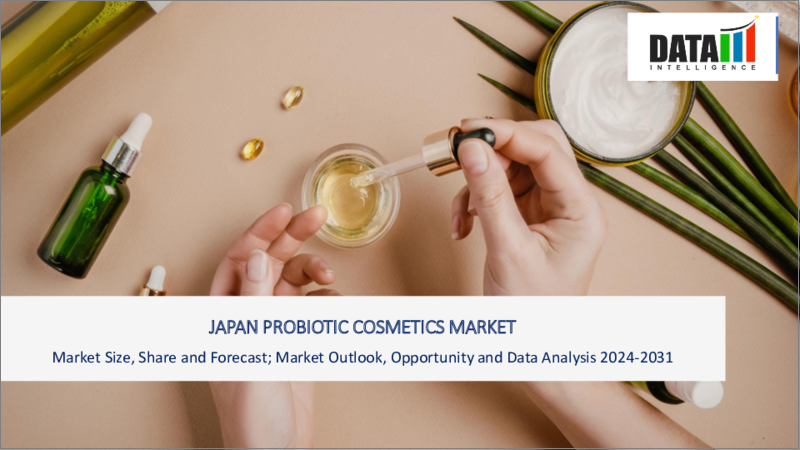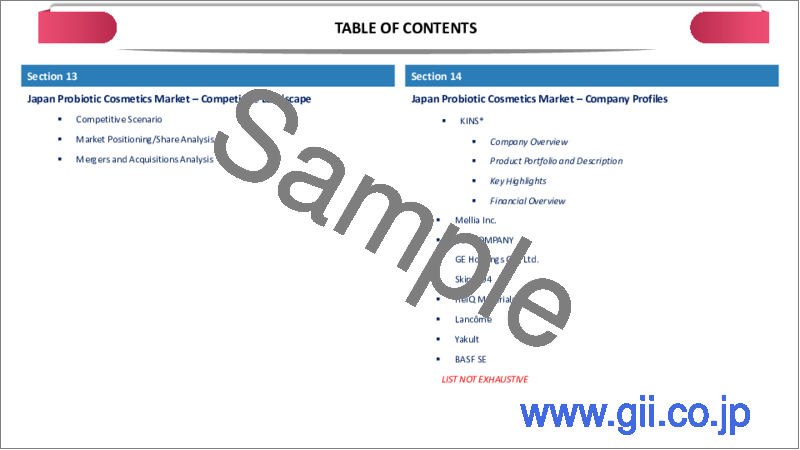|
|
市場調査レポート
商品コード
1560899
プロバイオティクス化粧品の日本市場:2024年~2027年Japan Probiotic Cosmetics Market - 2024-2027 |
||||||
カスタマイズ可能
適宜更新あり
|
|||||||
| プロバイオティクス化粧品の日本市場:2024年~2027年 |
|
出版日: 2024年09月23日
発行: DataM Intelligence
ページ情報: 英文 210 Pages
納期: 即日から翌営業日
|
- 全表示
- 概要
- 目次
レポート概要
日本のプロバイオティクス化粧品市場は、2023年に9,093万米ドルと評価され、2027年には1億2,496万米ドルに達する見込みで、予測期間(2024-2027年)のCAGRで8.43%の成長が予測されています。
日本のプロバイオティクス化粧品市場は、消費者の嗜好と技術の進歩が業界を形成する中で、いくつかの動向に見舞われています。市場の最も重要な動向は、皮膚マイクロバイオームの健康が重視されるようになっていることです。消費者が皮膚マイクロバイオームが皮膚全体の健康に果たす役割について認識を深めるにつれ、皮膚細菌の自然なバランスをサポートし、強化するプロバイオティクス化粧品への需要が高まっています。
微生物に優しい製品へのシフトは市場の革新を促し、各ブランドは生きたプロバイオティクス、プレバイオティクス、ポストバイオティクスを組み込んだ新しい処方を開拓しています。これらの成分は、肌の自然な防御力を強化し、回復力を高め、健康的な輝きを促進します。この市場では、マイクロバイオームバランスを回復させることで、ニキビ、湿疹、酒さなどの皮膚疾患を改善すると謳う製品が急増しており、科学的裏付けのある効果的なスキンケアソリューションを求める消費者の欲求に応えています。
市場促進要因
スキンケア効果に対する意識の高まり
肌の悩みの増加が日本におけるプロバイオティクス化粧品市場の成長を後押ししています。2023年12月、DHCが日本の20代から50代の有職女性1,000人を対象に行った調査によると、自分の肌に自信があるのはわずか17.6%で、80%以上が自信がないと回答しました。20代では「毛穴」54.4%、「ニキビ」50.8%、「肌荒れ」50.8%。30代では、58.4%が毛穴、54.8%がシミ、45.6%が乾燥に悩んでいます。40代では70%、50代では74.4%がシミに悩んでいます。
プロバイオティクス化粧品は、肌本来のバリア機能とマイクロバイオームをサポートすることで、ホリスティックな肌の健康を促進すると認識されています。これは、消費者が全体的な健康に寄与する製品を優先する、日本における広範なウェルネス動向と一致しています。皮膚マイクロバイオータのバランスを整え、皮膚の健康を改善することで知られるプロバイオティクス化粧品は、より優しく効果的な治療法を求める女性にアピールします。
高齢化人口の増加
日本における高齢化人口の増加は、プロバイオティクス化粧品市場の重要な促進要因です。高齢者の割合が最も高い国の一つとして、日本の人口動態の変化は消費者の嗜好を形成し、成熟した肌のニーズに応えるスキンケア製品に対する需要を増大させています。例えば、2023年9月現在、日本の人口の10%以上が80歳以上であり、世界最高齢人口国としての地位を確固たるものにしています。この人口動態の変化は、日本の経済、労働力、社会に大きな影響を与えています。
世界経済フォーラムの「雇用の未来レポート2023」によると、55歳以上の従業員を優先的に採用する企業はわずか35%に過ぎないです。日本の高齢化率は上昇を続けており、住民の約3分の1が65歳以上(約3,623万人)です。日本は高齢者人口において世界的にトップの地位を維持しており、65歳以上の人口比率は、次に高齢な国としてランクされているイタリアと比較して際立って高いです。
プロバイオティクスは、皮膚マイクロバイオームのバランスを整え、皮膚のバリア機能を高め、皮膚全体の活力を促進するため、こうした背景から人気を集めています。こうした利点は、肌本来のプロセスをサポートする、優しくも効果的なスキンケアソリューションを求める高齢の消費者には特に魅力的です。その結果、各ブランドは成熟した肌のニーズを満たすよう特別に設計されたプロバイオティクス製剤の開発に注力しています。
市場抑制要因
化粧品に対する厳しい規制と基準
日本は、安全性、有効性、表示に関する厳しい要件を含む、化粧品に関する厳格な規制枠組みで知られています。こうした規制は、消費者の安全性と製品の品質を確保するためのものであるが、同市場で事業を展開する企業にとっては大きな課題ともなりえます。
例えば、日本における化粧品の規制は、厚生労働省と医薬品医療機器総合機構(PMDA)によって管理されています。これらの規制は薬事法(昭和35年法律第145号)に基づき、化粧品の安全性、有効性、品質を確保し、消費者の健康を守ることを目的としています。
日本のプロバイオティクス化粧品市場では、こうした厳しい規制の遵守に時間とコストがかかります。特に生きたプロバイオティクスを配合する場合、製品の安全性と有効性を示す包括的な証拠を提出する必要があるため、さらに複雑さが増します。このような規制の負担は、製品開発を遅らせ、コストを増加させ、市場の成長とイノベーションのペースを制限する可能性があります。
目次
第1章 調査手法と調査範囲
第2章 定義と概要
第3章 エグゼクティブサマリー
第4章 市場力学
- 影響要因
- 促進要因
- スキンケア効果に対する意識の高まり
- 高齢化人口の増加
- 抑制要因
- 化粧品に対する厳しい規制と基準
- 機会
- 影響分析
- 促進要因
第5章 産業分析
- ポーターのファイブフォース分析
- サプライチェーン分析
- 価格分析
- 規制分析
- DMIの見解
第6章 タイプ別
- フェイシャルケア製品
- クリーム
- ローション
- 洗顔料
- 美容液
- その他
- ヘアケア製品
- シャンプー
- コンディショナー
- 美容液
- その他
- ボディケア製品
- デオドラント
- 角質ケア
- 石鹸
- ボディローション
- その他
- ネイルケア製品
- その他
- メイクアップ製品
- 女性用インティメイトケア製品
第7章 成分別
- 乳酸菌
- レンサ球菌
- ビフィズス菌
- その他
第8章 消費者志向別
- 男性
- 女性
第9章 用途別
- 肌の健康
- アンチエイジング
- 美白
- 抗炎症
- 光保護効果
- その他
- 毛髪の健康
- 抜け毛
- 育毛
- 頭皮洗浄
- その他
- 爪の健康
第10章 包装別
- チューブ
- ボトル
- ジャー
- ポンプ・ディスペンサー
- その他
第11章 流通チャネル別
- スーパーマーケット/ハイパーマーケット
- 薬局・ドラッグストア
- コンビニエンスストア
- オンライン小売業者
- その他
第12章 持続可能性分析
- 環境分析
- 経済分析
- ガバナンス分析
第13章 競合情勢
- 競合シナリオ
- 市況/シェア分析
- M&A分析
第14章 企業プロファイル
- KINS
- 会社概要
- 製品ポートフォリオと概要
- 財務概要
- 主な発展
- Mellia Inc.
- BCL COMPANY
- GE Holdings Co., Ltd.
第15章 付録
Report Overview
The Japan probiotic cosmetics market recorded a value of US$ 90.93 million in 2023 and is expected to reach a value of US$ 124.96 million in 2027, growing at a CAGR of 8.43% during the forecast period (2024-2027).
The Japanese probiotic cosmetics market is experiencing several trends as consumer preferences and technological advancements shape the industry. The most significant trend in the market is the increasing emphasis on skin microbiome health. As consumers become more aware of the skin microbiome's role in overall skin health, there is a growing demand for probiotic cosmetics that support and enhance the natural balance of skin bacteria.
This shift towards microbiome-friendly products drives innovation in the market, with brands developing new formulations that incorporate live probiotics, prebiotics, and postbiotics. These ingredients strengthen the skin's natural defenses, improve its resilience, and promote a healthy glow. The market is witnessing a surge in products that claim to improve skin conditions such as acne, eczema, and rosacea by restoring microbiome balance, catering to consumers' desire for effective, science-backed skincare solutions.
Market Drivers
Growing Awareness of Skincare Benefits
The rise in skin concerns is fueling the growth of the probiotic cosmetics market in Japan. In December 2023, a DHC survey of 1,000 Japanese employed women in their twenties to fifties showed that only 17.6% were confident in their skin, while over 80% were unconfident. For women in their twenties, 54.4% had issues with pores, 50.8% with acne, and 50.8% with roughness. In their thirties, 58.4% struggled with pores, 54.8% with blemishes, and 45.6% with dryness. Blemishes were the main concern for 70% of women in their forties and 74.4% in their fifties.
Probiotic cosmetics are perceived as promoting holistic skin health by supporting the skin's natural barrier function and microbiome. This aligns with the broader wellness trend in Japan, where consumers prioritize products that contribute to overall well-being. Probiotic cosmetics, known for balancing skin microbiota and improving skin health, appeal to women looking for gentler, effective remedies.
Growing Aging Population
The growing aging population in Japan is a significant driver of the probiotic cosmetics market. As one of the countries with the highest proportion of elderly citizens, Japan's demographic shift is shaping consumer preferences and increasing the demand for skincare products that cater to mature skin needs. For instance, as of September 2023, more than 10% of Japan's population is aged 80 or older, solidifying its status as having the world's oldest population. This demographic shift is significantly impacting Japan's economy, workforce, and society.
According to the World Economic Forum's Future of Jobs Report 2023, only 35% of companies prioritize employees aged 55 and older. The country's aging population continues to grow, with nearly a third of its residents being over 65-approximately 36.23 million individuals. Japan maintains a leading position globally in terms of its elderly population, with a notably higher percentage of people over 65 compared to Italy, which ranks as the next oldest country.
Probiotics are gaining popularity in this context because they help to balance the skin microbiome, enhance skin barrier function, and promote overall skin vitality. These benefits are particularly appealing to older consumers who are looking for gentle yet effective skincare solutions that support their skin's natural processes. As a result, brands are focusing on developing probiotic formulations that are specifically designed to meet the needs of mature skin.
Market Restraints
Strict Regulations and Standards for Cosmetic Products
Japan is known for its rigorous regulatory framework governing cosmetic products, which includes stringent requirements for safety, efficacy, and labeling. These regulations are designed to ensure consumer safety and product quality but can also create significant challenges for companies operating in the market.
For instance, the regulation of cosmetics in Japan is managed by the Ministry of Health, Labour and Welfare (MHLW) and the Pharmaceutical and Medical Devices Agency (PMDA). These regulations fall under the Pharmaceutical Affairs Law (Law No. 145 of 1960), which is designed to ensure the safety, efficacy, and quality of cosmetics, thereby safeguarding consumer health.
In the Japanese probiotic cosmetics market, compliance with these strict regulations can be both time-consuming and costly. The need to provide comprehensive evidence of a product's safety and efficacy, particularly when incorporating live probiotics, adds a layer of complexity. This regulatory burden can slow down product development and increase costs, potentially limiting the market's growth and innovation pace.
Segment Analysis
The Japan probiotic cosmetics market is segmented based on type, ingredient, consumer orientation, application, packaging, and distribution channel.
Growing Demand for Natural Skin Care Products
Skin health holds a significant share in the Japan probiotic cosmetics market due to the growing consumer demand for products that promote overall skin wellness through microbiome care. Probiotic cosmetics, which incorporate beneficial bacteria like prebiotics, probiotics, and postbiotics, are gaining popularity for their ability to improve skin barrier function, reduce inflammation, and combat issues such as acne, dryness, and sensitivity.
On September 28, 2022, Japanese beauty giant Shiseido acquired Gallinee Ltd, a London-based beauty brand focused on microbiome care. Gallinee offers science-backed beauty products with a patented complex of prebiotics, probiotics, and postbiotics to nourish and strengthen the skin's microbiome. This acquisition supports Shiseido's mission to integrate skin beauty and inner beauty.
Sustainability Analysis
The Japan probiotics cosmetics market is experiencing a notable shift toward sustainability, driven by increasing consumer awareness and demand for eco-friendly products. Brands are increasingly incorporating probiotics, known for their skin-beneficial properties, into formulations that not only enhance skin health but also promote environmental responsibility. Sustainable sourcing of ingredients is a priority, with many companies emphasizing natural, organic, and responsibly harvested components, thereby reducing their ecological footprint.
Packaging innovations, such as biodegradable materials and refillable containers, are gaining traction as brands seek to minimize waste. Additionally, manufacturers are investing in clean production processes to ensure minimal environmental impact during manufacturing. The rise of cruelty-free and vegan-certified products reflects a growing ethical consciousness among consumers.
Unmet Needs
While there are a growing number of probiotic skincare products available, many consumers seek more tailored solutions that address their unique skin concerns and preferences. Customizable skincare routines that allow consumers to select and combine probiotic ingredients based on their skin profiles are in demand. This level of personalization would help differentiate brands in the competitive market and meet the evolving expectations of consumers who are looking for more than just general skincare solutions.
Furthermore, there is an unmet need in the market for rigorous scientific validation of probiotic cosmetic products. While many products claim to harness the benefits of probiotics, there is often a lack of clinical evidence supporting these claims. Consumers are becoming increasingly discerning and seek products backed by scientific research that demonstrates their efficacy and safety.
Market Competitive Landscape
The major players in the market include KINS, Mellia Inc., BCL COMPANY, and GE Holdings Co., Ltd.
By Type
Facial Care Products
Creams
Lotions
Cleanser
Serums
Others
Hair Care Products
Shampoo
Hair Conditioner
Hair Serums
Others
Body Care Products
Deodorants
Exfoliants
Soaps
Body Lotions
Others
Nail Care Products
Others
Make-up Products
Female Intimate Care Products
By Ingredient
Lactobacillus
Streptococcus
Bifidobacterium
Others
By Consumer Orientation
Male
Female
By Application
Skin Health
Acne
Anti-Ageing
Skin Whitening
Anti-Inflammatory
Photoprotective Effects
Others
Hair Health
Hair Fall
Hair Growth
Scalp Cleaning
Others
Nail Health
By Packaging
Tubes
Bottles
Jars
Pumps and Dispensers
Others
By Distribution Channels
Supermarkets/Hypermarkets
Pharmacies and Drug Stores
Convenience Stores
Online Retailers
Other Distribution Channels
Why Purchase the Report?
To visualize the Japan probiotic cosmetics market segmentation based on type, ingredient, consumer orientation, application, packaging, and distribution channel, as well as understand key commercial assets and players.
Identify commercial opportunities by analyzing trends and co-development.
Excel data sheet with numerous data points of Japan probiotic cosmetics market-level with all segments.
PDF report consists of a comprehensive analysis after exhaustive qualitative interviews and an in-depth study.
Product mapping available as excel consisting of key products of all the major players.
The Japan probiotic cosmetics report would provide approximately 30 tables, 41 figures and 210 pages.
Target Audience 2024
Manufacturers/ Buyers
Industry Investors/Investment Bankers
Research Professionals
Emerging Companies
Table of Contents
1. Methodology and Scope
- 1.1. Research Methodology
- 1.2. Research Objective and Scope of the Report
2. Definition and Overview
3. Executive Summary
- 3.1. Snippet by Type
- 3.2. Snippet by Ingredient
- 3.3. Snippet by Consumer Orientation
- 3.4. Snippet by Application
- 3.5. Snippet by Packaging
- 3.6. Snippet by Distribution Channel
4. Dynamics
- 4.1. Impacting Factors
- 4.1.1. Drivers
- 4.1.1.1. Growing Awareness of Skincare Benefits
- 4.1.1.2. Growing Aging Population
- 4.1.2. Restraints
- 4.1.2.1. Strict Regulations and Standards for Cosmetic Products
- 4.1.3. Opportunity
- 4.1.4. Impact Analysis
- 4.1.1. Drivers
5. Industry Analysis
- 5.1. Porter's Five Force Analysis
- 5.2. Supply Chain Analysis
- 5.3. Pricing Analysis
- 5.4. Regulatory Analysis
- 5.5. DMI Opinion
6. By Type
- 6.1. Introduction
- 6.1.1. Market Size Analysis and Y-o-Y Growth Analysis (%), By Type
- 6.1.2. Market Attractiveness Index, By Type
- 6.2. Facial Care Products*
- 6.2.1. Introduction
- 6.2.2. Market Size Analysis and Y-o-Y Growth Analysis (%)
- 6.2.3. Creams
- 6.2.4. Lotions
- 6.2.5. Cleanser
- 6.2.6. Serums
- 6.2.7. Others
- 6.3. Hair Care Products
- 6.3.1. Shampoo
- 6.3.2. Hair Conditioner
- 6.3.3. Hair Serums
- 6.3.4. Others
- 6.4. Body Care Products
- 6.4.1. Deodorants
- 6.4.2. Exfoliants
- 6.4.3. Soaps
- 6.4.4. Body Lotions
- 6.4.5. Others
- 6.5. Nail Care Products
- 6.6. Others
- 6.6.1. Make-up Products
- 6.6.2. Female Intimate Care Products
7. By Ingredient
- 7.1. Introduction
- 7.1.1. Market Size Analysis and Y-o-Y Growth Analysis (%), By Ingredient
- 7.1.2. Market Attractiveness Index, By Ingredient
- 7.2. Lactobacillus*
- 7.2.1. Introduction
- 7.2.2. Market Size Analysis and Y-o-Y Growth Analysis (%)
- 7.3. Streptococcus
- 7.4. Bifidobacterium
- 7.5. Others
8. By Consumer Orientation
- 8.1. Introduction
- 8.1.1. Market Size Analysis and Y-o-Y Growth Analysis (%), By Consumer Orientation
- 8.1.2. Market Attractiveness Index, By Consumer Orientation
- 8.2. Male*
- 8.2.1. Introduction
- 8.2.2. Market Size Analysis and Y-o-Y Growth Analysis (%)
- 8.3. Female
9. By Application
- 9.1. Introduction
- 9.1.1. Market Size Analysis and Y-o-Y Growth Analysis (%), By Application
- 9.1.2. Market Attractiveness Index, By Application
- 9.2. Skin Health*
- 9.2.1. Introduction
- 9.2.2. Market Size Analysis and Y-o-Y Growth Analysis (%)
- 9.2.3. Anti-Ageing
- 9.2.4. Skin Whitening
- 9.2.5. Anti-Inflammatory
- 9.2.6. Photoprotective Effects
- 9.2.7. Others
- 9.3. Hair Health
- 9.3.1. Hair Fall
- 9.3.2. Hair Growth
- 9.3.3. Scalp Cleaning
- 9.3.4. Others
- 9.4. Nail Health
10. By Packaging
- 10.1. Introduction
- 10.1.1. Market Size Analysis and Y-o-Y Growth Analysis (%), By Packaging
- 10.1.2. Market Attractiveness Index, By Packaging
- 10.2. Tubes*
- 10.2.1. Introduction
- 10.2.2. Market Size Analysis and Y-o-Y Growth Analysis (%)
- 10.3. Bottles
- 10.4. Jars
- 10.5. Pumps and Dispensers
- 10.6. Others
11. By Distribution Channel
- 11.1. Introduction
- 11.1.1. Market Size Analysis and Y-o-Y Growth Analysis (%), By Distribution Channel
- 11.1.2. Market Attractiveness Index, By Distribution Channel
- 11.2. Supermarkets/Hypermarkets*
- 11.2.1. Introduction
- 11.2.2. Market Size Analysis and Y-o-Y Growth Analysis (%)
- 11.3. Pharmacies and Drug Stores
- 11.4. Convenience Stores
- 11.5. Online Retailers
- 11.6. Other Distribution Channels
12. Sustainability Analysis
- 12.1. Environmental Analysis
- 12.2. Economic Analysis
- 12.3. Governance Analysis
13. Competitive Landscape
- 13.1. Competitive Scenario
- 13.2. Market Positioning/Share Analysis
- 13.3. Mergers and Acquisitions Analysis
14. Company Profiles
- 14.1. KINS*
- 14.1.1. Company Overview
- 14.1.2. Type Portfolio and Description
- 14.1.3. Financial Overview
- 14.1.4. Key Developments
- 14.2. Mellia Inc.
- 14.3. BCL COMPANY
- 14.4. GE Holdings Co., Ltd. (*LIST NOT EXHAUSTIVE)
15. Appendix
- 15.1. About Us and Services
- 15.2. Contact Us






